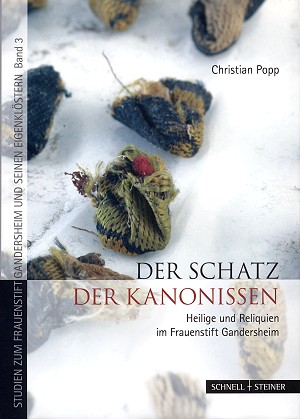
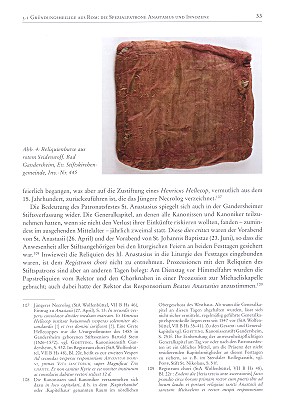
| ANNE WANNER'S Textiles in History / books |
Christian Popp
|
| Inhaltsverzeichnis: Vorwort 1. Einleitung 2. Quellen und Forschungsstand 3. Die Patrone der Stifterfamilie - Gandersheim als liudolfingisches Eigenstift 4. Der Glanz des Herrschers - der Gandersheimer Kirchenschatz in ottonischer Zeit 4.1. Gandersheim und die ottonischen Könige 4.2 Reliquien zur Weihe der Altäre? Eine Analyse der materiellen Überlieferung Untersuchung der Reliquienbündel aus Reliquienstoff 1 durch Prof. Dr. Annemarie Stauffer, Fachhochschule Köln, Institut für Konservierungswissenschaft, August 2009 5. Der Gandersheimische Heiligenhimmel - Funktion, Provenienz, Quantität und Qualität 6. Anhang |
 |
 |
| in english: |
| Information
about Gandersheim as in wikipedia: Gandersheim Abbey was a proprietary foundation by Duke Liudolf of Saxony and his wife Oda, who during a pilgrimage to Rome in 846 obtained the permission of Pope Sergius II for the new establishment and also the relics of the sainted former popes Anastasius and Innocent, who are still the patron saints of the abbey church. The community settled first at Brunshausen. The first abbess was Hathumod, a daughter of Liudolf, as were the two succeeding abbesses. In 856 construction began on the church at Gandersheim and in 881 Bishop Wigbert dedicated it to the Saints Anastasius, Innocent and John the Baptist, after which the community moved in. Already in 877 King Louis the Younger placed the abbey under the protection of the Empire, which gave it extensive independence. The close connection to the Empire meant that the abbey was obliged to provide accommodation to the German kings on their travels, and numerous royal visits are recorded. The establishment of the abbey by the founder of the Liudolfingers gave it especial importance during the Ottonian period. Until the foundation of Quedlinburg Abbey in 936, Gandersheim was among the most important Ottonian family institutions, and its church was one of the Ottonian burial places. The canonesses, commonly known as Stiftsdamen, were allowed private property and as they had taken no vows, were free at any time to leave the abbey. The Ottonian and Salian kings and their entourages often stayed in Gandersheim, and the canonesses were by no means remote from the world. Apart from the memorial masses for the founding family, one of the main duties of the canonesses was the education of the daughters of the nobility (who were not obliged to become canonesses themselves). The abbey is now used by the Evangelical-Lutheran parochial group of St. Anastasius and St. Innocent. During restoration works in 1997 there came to light some of the old church treasure: relics, textiles and reliquaries. These have been on display since March 2006. http://en.wikipedia.org/wiki/Gandersheim_Abbey |
| Content of the book: |
| Important
for the liturgy before Reformation are two manuscripts.
One of it is the Registrum chori ecclelsie maioris Gandersemensis, it is published in the appendix of the book, as well as a list of documents which are published or not published. |
| Inventories
and documents mention relics or church
treasures: - from the 12th c. onward there is a well preserved and up to date list of treasures. - in the library, in 1956, a list of relics came to light in the cover of a book of the 16th c. - from the 16th to the 19th c. there are printed inventaries - in 1973 documents of the convent were published. |
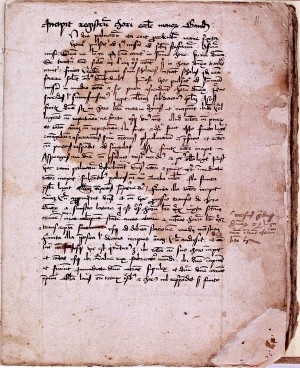 Registrum chori - StA Wolfenbüttel, VII B Hs 48 |
|
| In
the center of the book in question and of the research
there is a collection of more than 200 small
packages with relics of Saints, which are
carefully wrapped in precious textiles. The Saints were
worshipped in Gandersheim as helper, as protector of
possession, as guarantee for salvation. The analyses of the textiles show that almost 100 of them were made from identical fabrics, which had been woven between the early 9th c. and the late 10th c. About 70 of the packages are provided with readable authentics and it is possible to date 18 of them in the 10th and 11th c. It is obvious that 3 different methods of wrapping the relics were used. Most probably 3 persons were occupied in the production of the packages. In Gandersheim many Saints were worshipped: Christ, John the Baptist, S. Peter, S. Stefanus, 9 Martyrs and also the bishop Adalbert of Prag who died a martyr's death in 997. Female saints are: the virgin Mary and Saints like Regula, Margareta and Juliana. |
 Packages with relics, fabric Nr 1, Inv.Nr. 396-2 |
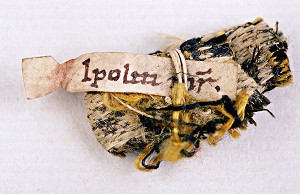 Relic of Saint Hyppolyt |
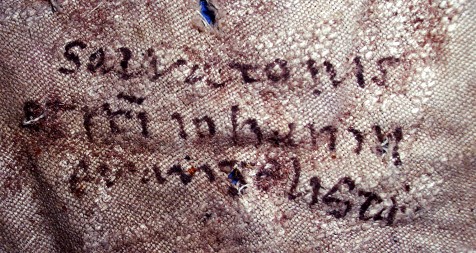 Inscription 8th/9th century of cloth of Salvator |
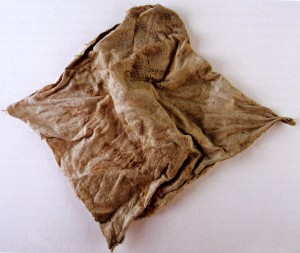 Cloth of Salvator, Ev. Stiftskirchengemeinde, Inv.NR. 394 |
| The
church of Gandersheim was consecrated in 1007.
This inauguration most probably was a reason to receive
further relics. Particles of relics were laid down at the
altars which were consecrated. In ottonian times the
presence of the emperor in such occasions was important.
It was an opportunity to consolidate the political
network between the church and the secular elits. The
exchance of presents caused durabel political and social
commitments. Emperors were obliged to make, to receive
and to return presents. One chapter of the book deals with the importance of Saints and relics in the liturgy of the Abbey church. Since Carolingian times relics of saints used to be deposited in altars. It is supposed that in the middle of 15th c. most of the relics were deposited in the high altar. There is a document preserved who mentions 4 keys which had to be kept by different people. Most probably they were part of a medieval lock and key system with several locks and it belonged to a shrine on the high altar itself. After Reformation the relics were translated in the western part of the building. In July 1543 during iconoclasm 16 altars were destroyed in Gandersheim. Some of them were reconstructed shortley afterwards and consecrated in 1550. Obviously some of the relics were put back, maybe wrapped newly and provided with new labels. There were also altars in the "paradise hall", which served as a main burial place. This hall was pulled down in 1838. Besides of a deposition in altars there were also shrines and mobile vessels with relics. It is also known that the bones of the Pope Innocenz and Anastasius were translated to the place where archives are kept, and finally buried in 1958 in the church of the Abbey. The use of relics before Reformation is handed down to us in the manuscript Registrum Chori. Its directions point to altars which were part of the liturgy on sundays and on important church festivals. |
| home content | Last revised 11 September, 2010 |